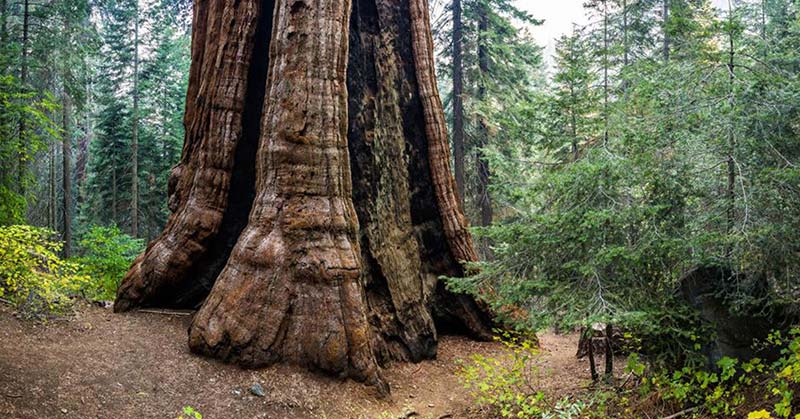Forests cover approximately 30% of the world’s land area, but sadly, they are disappearing at a rapid pace. From 1990 to 2016, 1.3 million square kilometers of forest were lost, according to the World Bank. [1] According to a 2015 study, 46% of the world’s trees have been destroyed since humans first began cutting down trees. [2] To say that trees are in trouble could be a bit of an understatement. So any opportunity to protect the forests of the world should be seized upon. And that’s exactly what happened last year in California.
In September of 2019, it was announced that a conservation group had wrapped up a nearly $16 million deal to purchase the largest privately owned giant sequoia forest in the world. The grove, called Alder Creek, is home to hundreds of giant sequoias, which can live up to 3,000 years and grow as tall as the Statue of Liberty. [3]
Save the Redwoods League, a California-based non-profit organization announced the deal last September. The organization has been working to acquire this grove of giant sequoias for over two decades. The grove is unique for giant sequoias – it has a diverse array of different aged giant sequoias.
“Many giant sequoia groves are just a single age class, usually in the thousands,” Sam Hodder, president and CEO of SRL told MNN in an interview. [4] “In this one, a real indication of its health and resilience is that there are giant sequoia of all age ranges.”
“It’s rarer still to have multiple age classes, and such a healthy forest ecosystem.”
SRL obtained the grove from the Rouch Family, which has owned the forest since the 1940s. SRL was able to fundraise the necessary $15.6 million to purchase the grove from a public fundraising drive [5] on its website. More than 8,500 donors from around the world pitched in to help protect the giant sequoia grove.
A tree in trouble
When you think about endangered species, you probably picture animals like tigers, rhinos, frogs, and so on. But plants are just as susceptible to extinction as animals, and trees are no exception. Giant sequoia trees are considered an endangered species by the International Union for Conservation of Nature, or IUCN. [6]
In prehistoric times, giant sequoias were a pretty common tree around the world. Fossil records indicated that at one point, they grew throughout North America and Eurasia, but the most recent ice age drastically reduced their range. [7] Today, there are only 73 scattered groves of the trees spread out through the Sierra Nevada range of California. These fragmented forests continue to be threatened by unsustainable development, forest fires in fire suppressed forests and climate change. [8]
The greatest threat to giant sequoia trees are forest fires. Historically, the trees have weathered forest fires without issue due to their size and the thickness of their bark. But since the 1800s, humans have been suppressing natural forest fires. This has caused an increase of undergrowth in forests where giant sequoias live. Because the undergrowth is so overgrown, when the forests do burn, the fires burn hotter and more fiercely. The naturally fire-resistant sequoia trees cannot protect themselves from these fires.
“Because we’ve been suppressing forest fires that used to occur on a regular basis in this landscape, all the species that would be kind of culled by a natural, low-burning fire have been allowed to grow to maturity in an unnatural way,” Hodder says. “So one of the challenges in stewardship of giant sequoia is finding a way to address that unnatural buildup of combustible fuels.”
A plan to transfer ownership
Alder Creek is situated near Giant Sequoia National Monument, a 328,000 acre protected space that connects to Sequoia National Forest. Alder Creek has been used for commercial logging but ceased logging giant sequoia trees in the 1960s. SRL will eventually give ownership of the land to the U.S. Forest Service so the grove can be connected to other protected sequoia groves. The process is expected to take 5-10 years.
“This property has been in private ownership, and it has never had public access,” says Hodder. “We want to go through a thoughtful process to plan out public access, so when it does get conveyed into the national monument, it’s ready for its public purpose.”
Keep Reading: Rainbow Snake Seen In Florida’s Ocala National Forest For First Time since 1969
- https://blogs.worldbank.org/opendata/five-forest-figures-international-day-forests
- https://www.nature.com/articles/nature14967
- https://www.livescience.com/39461-sequoias-redwood-trees.html
- https://www.mnn.com/earth-matters/wilderness-resources/blogs/alder-creek-giant-sequoia-grove-save-redwoods-league
- https://secure3.convio.net/srl/site/Donation2
- https://www.iucnredlist.org/species/34023/2840676
- https://www.monumentaltrees.com/en/trees/giantsequoia/history/
- https://www.savetheredwoods.org/redwoods/giant-sequoias/

